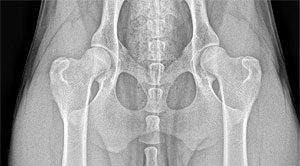
What is Canine Hip Dysplasia?
Canine Hip Dysplasia typically develops because of an abnormally developed hip joint, but can also be caused by cartilage damage from a traumatic fracture. With cartilage damage or a hip joint that isn’t formed properly, over time the existing cartilage will lose its thickness and elasticity. This breakdown of the cartilage will eventually result in pain with any joint movement.
No one can predict when or even if a dysplastic dog will start showing clinical signs of lameness due to pain. The severity of the disease can be affected by environmental factors, such as caloric intake or level of exercise. There are a number of dysplastic dogs with severe arthritis that run, jump, and play as if nothing is wrong and some dogs with barely any arthritic x-ray evidence that are severely lame.
The hip grades of excellent, good and fair are within normal limits and are given OFA numbers. This information is accepted by AKC on dogs with permanent identification and is in the public domain. Radiographs of borderline, mild, moderate and severely dysplastic hip grades are reviewed by a team of consultant radiologists and a radiographic report is generated documenting the abnormal radiographic findings. Unless the owner has chosen the open database, dysplastic hip grades are closed to public information.
Hip Xrays

Excellent: Superior conformation; there is a deep-seated ball (femoral head) that fits tightly into a well-formed socket(acetabulum) with minimal joint space.

Borderline: Not clear. Usually more incongruency present than what occurs in a fair but there are no arthritic changes present that definitively diagnose the hip joint being dysplastic.
Mild: Significant subluxation present where the ball is partially out of the socket causing an increased joint space. The socket is usually shallow only partially covering the ball.

Good: Slightly less than superior but a well-formed congruent hip joint is visualized. The ball fits well into the socket and good coverage is present.

Moderate: The ball is barely seated into a shallow socket. There are secondary arthritic bone changes usually along the femoral neck and head (remodeling), acetabular rim changes (osteophytes or bone spurs) and various degrees of trabecular bone pattern changes (sclerosis).

Fair: Minor irregularities; the hip joint is wider than a good hip. The ball slips slightly out of the socket. The socket may also appear slightly shallow.

Severe: Marked evidence that hip dysplasia exists. The ball is partly or completely out of a shallow socket. Significant arthritic bone changes along the femoral neck and head and acetabular rim changes
